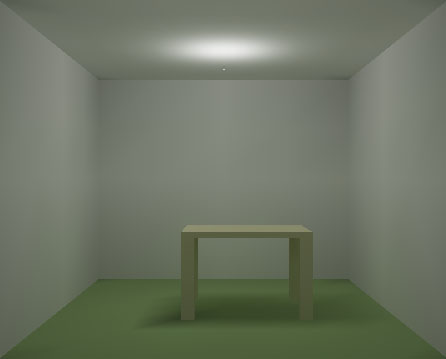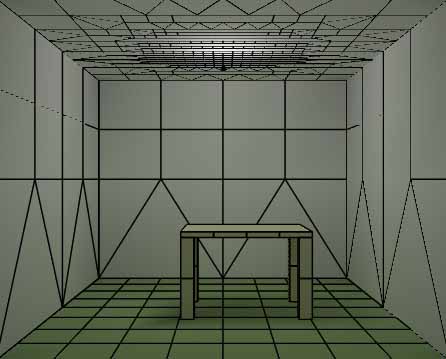3D Animation Workshop: Lesson 46: The Natural Magic of Radiosity webreference.com
|
|
Lesson 46 - The Natural Magic of Radiosity - Part 2
In conventional 3-D computer graphics, there is a fundamental distinction between geometric objects and lights. The geometry receives light, but it does not emit light. Ray tracing can be used to render reflections on shiny surfaces, but this technique does not address a basic physical reality. In the real world, much (and generally most) of the light in a given space is reflected off of surfaces. The diffuse colors of the surfaces in a room mix to create an atmosphere.
Radiosity can simulate this reality with remarkable success. The solution process begins with the lights, computing how much direct illumination falls on the surfaces. Then all of the different surfaces are treated much like lights. The reflected illumination of each surface is added to the picture, and the whole process is repeated again and again until the composite of reflected light reaches a satisfactory level. We actually watch the lighting build on the Lightscape screen, and can stop the process whenever we feel it is complete.
In every image on these pages, the material color of the walls and ceiling is unchanged. It is a fairly reflective white. But when the color of the floor is changed, notice how the walls pick up the new color. Amazing!

It is just this subtle element that unifies the room with a discernible atmosphere, as though the light in the room has a color of its own. Because it does!
By adding a simple table, we discover another important feature of radiosity.

The gentle shadows typical of soft indoor lighting are very difficult to achieve with conventional rendering methods. But Lightscape produces these shadows easily and convincingly. They contribute so much to atmosphere, and are esthetically pleasing. Take a look at a mesh view of the solution.

Shadows this soft require no finer meshing than we used in the scene without the table. These are gentle gradients. I stress this point because, while radiosity is ideal for soft shadows, it can be very troublesome for more sharply defined ones. In fact, I had to eliminate the harder shadows cast by the legs of the table (as opposed to the table top) because the radiosity solution generated some very unsightly artifacts. Using radiosity requires some judgment, and often some compromises with absolute verisimilitude.
Our room thus far is sterile because it lacks daylight. Let's open up a window and let some sun in.
| To Continue to Part 3, or Return to Part 1, Use Arrow Buttons |
|
Created: August 4, 1998
Revised: August 4, 1998
URL: https://webreference.com/3d/lesson46/part2.html


 Find a programming school near you
Find a programming school near you